March 12, 2010
Air Date: March 12, 2010
FULL SHOW
SEGMENTS
Pushing for Sea Changes
View the page for this story
At CITES, the Convention on International Trade of Endangered Species, representatives from 175 countries will focus on the necessity of developing management plans for marine animals, including the bluefin tuna and eight species of shark. Sharks are routinely hunted for their fins, which are used as a delicacy in shark fin soup. Stony Brook University professor Demian Chapman does DNA research to identify shark species and geographic origin. He tells host Jeff Young why it’s important to regulate international trade of sharks. (06:00)
Autism and Toxins
View the page for this story
The majority of autism research has focused on finding a genetic link to the disorder. But genetics only account for a quarter of all cases. Dr. Philip Landrigan of Mount Sinai School of Medicine tells host Jeff Young we should look to possible environmental links to autism, including the effects of chemical exposure on a fetus’ developing brain. (05:50)
Getting to the Bottom of Methane
View the page for this story
Scientists have discovered the permafrost beneath the East Siberian Arctic Shelf is melting, releasing large amounts methane into the atmosphere. Some say it could mean serious climate consequences, others say C02 is still the bigger problem. Host Jeff Young speaks with Dr. Matthew Reagan of the Lawrence Berkeley National Laboratory about the need to answer key questions before sounding the alarm about methane: how much and how fast? (06:00)
Tree Planting for Carbon Raises Questions
/ Beth HoffmanView the page for this story
When some villagers in southwestern Uganda began planting trees to bring back cooler temperatures and rain to their region, they caught the attention of the nation's foresters. The officials signed them up for East Africa's first tree carbon project. With funding from the World Bank, they'll receive money for storing carbon in newly-planted trees. But as Beth Hoffman reports, the project could have unintended consequences. (07:15)
Nuclear Shop of Horrors
/ Emily GuerinView the page for this story
Nuclear waste is extremely difficult to clean up. But, as Emily Guerin reports, a new synthetic material can snap up radioactive ions like a Venus fly-trap devours insects. (02:00)
Spring's A Comin'
/ Rick BassView the page for this story
It's been a long winter for Montana writer Rick Bass. But now, in March, he's finally seeing signs that spring is near. (02:45)
Seeds of Resistance
View the page for this story
A small group of plant scientists work tirelessly around the world to keep plant disease at bay. Now, they’re trying to find a strain of wheat resistant to stem rust, which is threatening the world’s wheat supply. Host Jeff Young talks with author Susan Dworkin whose book, “The Viking in the Wheat Field: A Scientist’s Struggle to Preserve the World’s Harvest,” follows the life of a man who was devoted to saving seeds from plants all over the world so that we will be able to fight future diseases. (07:30)
Hollywood’s Unrequited Scientist
View the page for this story
Frank Capra is best known for the movies "It's a Wonderful Life" and “Mr. Smith Goes to Washington,” but he also made films about global warming and solar energy more than 50 years ago. Capra's interest in science comes to life in "The Unchained Goddess," as well as the 1938 film "You Can't Take it With You." Frank Capra biographer Joseph McBride talks with host Jeff Young about Capra's frustrated scientific ambitions. (08:00)
Show Credits and Funders
Show Transcript
HOST: Jeff Young
GUESTS: Demian Chapman, Philip Landrigan, Matthew Reagan, Susan Dworkin
REPORTERS: Bruce Hoffman, Emily Geurrin
[THEME]
YOUNG: From Public Radio International - this is Living on Earth. I’m Jeff Young.
An international effort to keep sharks in the oceans and out of hot water.
CHAPMAN: The shark fin soup generates a demand for this product that is responsible for the death of somewhere between 22 and 73 million sharks annually.
YOUNG: How emerging science can help…Also, looking to the environment for answers on autism. And, the Hollywood legend who warned about climate change—fifty years ago.
FILM MUSIC & NARRATION: Well, it’s been calculated a few degrees rise in the earth’s temperature would melt the polar ice caps!
[DRAMATIC MUSIC FADE UNDER]
McBRIDE: He felt that science was as important or even more important than motion pictures, and we're probably glad he didn't go into science but he really felt he went into the wrong field.
YOUNG: Frank Capra—film giant and frustrated scientist. These stories and more this week on Living on Earth. Stay with us!
ANNOUNCER: Support for Living on Earth comes from the National Science Foundation and Stonyfield Farm.
Pushing for Sea Changes

Two different forms of shark fin go into this cup of shark fin soup. (Photo: Jeff Young)
YOUNG: From the Jennifer and Ted Stanley Studios in Somerville, Massachusetts –n this is Living on Earth. I’m Jeff Young. Representatives from 175 countries are gathering in Doha, Qatar, for CITES, The Convention on International Trade of Endangered Species. CITES sets worldwide rules on products like ivory and furs. This year CITES looks to the seas and could take important action to protect marine animals like the Atlantic bluefin tuna and some corals. Eight species of sharks will also be on the agenda.
A CITES proposal could cut the number of sharks that – too often – end up on the menu.
[SOUNDS OF RESTAURANT AMBIENCE]
YOUNG: In Boston’s Chinatown, a waitress serves up bowls of broth with what look like transparent noodles. That’s the cartilage from a shark’s fin. It’s shark-fin soup.

Two different forms of shark fin go into this cup of shark fin soup. (Photo: Jeff Young)
WAITRESS: We serve about 20 to 30 shark fin soup a day. When I was little, we eat it all the time. So, sometimes when we eat it, come back the memories that when we eat it in China or in Hong Kong.
YOUNG: Customers see shark fin soup as a reminder of home. Marine scientist Demian Chapman sees something else.
CHAPMAN: The shark fin soup generates a demand for this product that is responsible for the death of somewhere between 22 and 73 million sharks annually.
YOUNG: Chapman is Assistant Professor at the Institute for Ocean Conservation Science at Stony Brook University, where he works with shark DNA. What he can learn from a bowl of soup could help save some shark populations.
CHAPMAN: Well, by taking DNA from the shark fin soup you can actually tell two really important things. Number one, you can tell what species of shark was used to make the soup, and that’s important because different shark species reproduce somewhat differently and some of them are more vulnerable to fishing, and some of them are actually illegal to be captured and used for soup. The other thing you can do is you can use DNA to trace the fin that was used to make the soup all the way back to where it came from and where it was caught. And that’s really important because we need to know which regions contribute most to the shark fin trade and are catching the most sharks.
YOUNG: So, I understand how you could identify the species, but how do you identify the geographic region? How do you get that from the DNA sample?
CHAPMAN: The first thing is we get samples of the shark from all over the world, and we generate this map of where certain regions of DNA are the same or different. So we kind of map the genetic diversity of the shark species all across the globe. And then when we get to the point when we’re looking at a shark fin we can just take that same region of DNA and we sequence it, we look at our map, and we can trace it back to where it came from. It’s important because there are certain species that are very heavily fished in certain areas, and we need to know that so we can apply management in those areas.
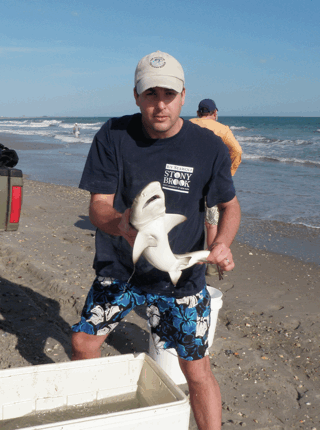
Professor Demian Chapman. (Courtesy of Stonybrook University)
YOUNG: So, what sharks are we concerned about here?
CHAPMAN: We’re particularly interested in protecting hammerhead sharks; the reason is that hammerhead sharks have extremely valuable fins. In fact, their fins go for around about 120 U.S. dollars per kilogram. And the hammerheads and many other sharks, they breed very, very slowly; they don’t reach sexual maturity until they’re about the same age that we are when we reach sexual maturity. And unlike, boney fish that spawn millions of eggs into the water column, sharks give birth to a relatively small number of offspring at a time.
So, they just can’t withstand heavy fishing pressure. For example, the scalloped hammerhead, one of the species up for listing, is in the northwest Atlantic there have been declines in the last 15 years, somewhere between 75 and 89 percent. So, that’s a pretty staggering level of decline for that particular species. There’s another species, the dusky shark in the same region has declined by more than 85 percent in the last 20 years. So, it’s not just a modest problem, these sharks are literally disappearing.

The Scalloped Hammerhead Shark is highly prized for its fin as the principle ingredient in shark fin soup. (Courtesy of The Alabama Department of Conservation and Natural Resources.)
YOUNG: And the pressure that’s forcing down the populations, it’s all just about the fin?
CHAPMAN: Yeah, the bulk of shark fisheries around the world – I mean the main product is these fins, and the fin, it’s really just a luxury dish and it’s really just sea-going status symbol. The shark fin soup used to be the emperor’s dish in ancient Chinese culture, so it’s something that conveyed wealth and status. So what’s really happened is that as the Chinese economy has grown in the last 20 years, it’s this middle class has sprung up and of course when they have a banquet or a wedding the ultimate dish to serve is the emperor’s dish, the shark fin soup.
YOUNG: So this month is the 15th meeting of the Convention on International Trade and Endangered Species, or CITES, in Doha, and sharks are on the agenda there. What would you like to see come out of the convention meeting?
CHAPMAN: What I would really like to see happen in the next couple weeks at Doha is for the seven large shark species that make up a big part of the global fin trade, I would like to see these species listed on what’s called Appendix Two. Now, Appendix Two is not a complete trade ban, but what it does is means that any fin of these species that crosses international borders will have to be accompanied by permits and that will give us a way to determine which places are contributing most to the fin trade, and in what volumes these species are being traded in. And in essence, they will be lifting the shroud of secrecy off the shark fin trade for the first time in history.
YOUNG: Demian Chapman at Stonybrook University’s Institute for Ocean Conservation Science. Thank you very much.
CHAPMAN: No problem.
Related links:
- Demian Chapman’s Web Page
- CITES Home Page
- Click Here to See a Video of Demian Chapman on Sharks
MUSIC: Various Artists/The Sunsets “Sharks” from Rare Tracks Collection Vol. 2 (The Orchard Records 2009)
Autism and Toxins

The structure of the insecticide chlorpyrifos. Until 2001, the chemical was used in homes and other places where children could be exposed. It is still widely used in agriculture. (Source: Wikimedia Commons)
YOUNG: The Centers for Disease Control estimate six out of every thousand U.S. children are diagnosed with some form of autism. The apparent increase in autism has alarmed parents and stymied scientists searching for a cause. Dr. Philip Landrigan argues in a medical journal that we should look to our environment for answers on autism. He’s a professor of pediatrics and community and preventative medicine at the Mount Sinai School of Medicine. Dr. Landrigan thinks a sustained focus on chemical exposures in the womb could tell us more than genetic studies have.
LANDRIGAN: I’ll begin by pointing out that there has been some very elegant genetic research done over the past five or ten years that has very successfully identified a number of genes and gene mutations that are responsible for a certain number of cases of autism. All together these genetic causes are responsible for something like 20 or 25 percent of cases. Well, that’s very important work and it’s very important to know that there are genetic causes, but at the same time those findings leave the causation of something like 75 percent of cases of autism unexplained.
YOUNG: So, genetics alone can’t explain this, what evidence do we have that environmental exposures might be a cause here?
LANDRIGAN: We know from other research on toxic chemicals that the developing human brain is very vulnerable to environmental toxins, we know about lead, we know about mercury, we know about PCBs, we know about certain pesticides, and for each of those chemicals we know that if the developing brain is exposed to the chemical early in development, especially in the early months of pregnancy, that the potential is very high for injury to the developing brain.
The second line of evidence I would call proof of principle. And this is the finding that there is a short list of chemicals that have been directly found to be linked to autism. The fact that early life exposure to these drugs can cause autism in certain children says to me that it’s possible other drugs, other environmental chemicals might also be responsible for some cases of autism.

The structure of the insecticide chlorpyrifos. Until 2001, the chemical was used in homes and other places where children could be exposed. It is still widely used in agriculture. (Source: Wikimedia Commons)
YOUNG: Now, also in this list that you have here you have a pesticide, a pretty commonly used pesticide.
LANDRIGAN: Yes, well, this is the most recent finding that a particular pesticide known as Clorpirifos, and organophosphate pesticide, is associated with pervasive developmental disorder, which a form of autism. There are more than 100 synthetic chemicals measurable in the bodies of virtually all Americans. So, we know that pregnant women, we know that children are being exposed to these chemicals.
The real problem is that we don’t know the potential toxicity of 80 percent of these high volume chemicals. In other words, we just – no testing has ever been done to determine whether these chemicals are safe or not, and as a pediatrician, I find this very worrisome that we’re allowing children to be exposed to chemicals whose possible hazard is simply not known.
YOUNG: We should also talk about the focus on vaccines. There’s some much attention to vaccines as a possible link to autism. How has that affected the overall field of looking for a real possible cause here?
LANDRIGAN: The question of the possible link between vaccines and autism is clearly a question that needed to be addressed. And approximately a dozen high quality studies were launched. It turns out now that not one of them has found any epidemiological connection between vaccines and autism. It’s time to begin to look systematically at other potential environmental causes of autism to see if we can find the triggers and then do something about them.

Major brain structures implicated in autism (Source: Wikimedia Commons)
YOUNG: There’s a lot of attention right now on reforming toxic chemical regulation and on increasing scrutiny on certain chemicals of concern. What evidence are you seeing that people are taking autism into account when they do these things?
LANDRIGAN: Well, I think people are beginning to connect the dots and realizing that there exists at least the potentiality, at least the possibility, that certain untested chemicals that are in children’s environments may be contributing to neuro-behavioral problems in children and the possibility exists that autism is among those.
The chemicals that I would put at the top of my list of suspicion are chemicals that fulfill two criteria: number one, they’re widely distributed in children’s environments, or the environments of pregnant women; and number two, there are chemicals where we already have some suspicion from experimental studies or from studies in adult workers exposed occupationally that these chemicals are neurotoxic.
YOUNG: You know, in a way this is pretty scary because the upshot of what you’re suggesting here is that there are exposures that in many cases may be well beyond our control that may determine whether or not our child is autistic, but on the other hand, it also implies we can figure this out and do something about it.
LANDRIGAN: Yes, at the end of the day, I think the message here is fundamentally optimistic. I strongly believe that for 500 years knowledge has guided medicine, evidence has guided prevention, and time and again we have shown as a society that when we understand the causes of disease we can take action to prevent it.
YOUNG: Dr. Philip Landrigan at the Mount Sinai School of Medicine in New York. Thank you for your time.
LANDRIGAN: You’re very welcome, Jeff. Thank you.
YOUNG: Dr. Landrigan’s proposal appears in Current Opinion in Pediatrics. For more information, go to our website, l-o-e dot org.
Related links:
- Click here to read the abstract of Landrigan's paper on the environmental factors of autism.
- To listen to a longer version of LOE's interview with Dr. Landrigan, click here
MUSIC: Reagan: Brad Mehldau “When It Rains” from Largo (Warner Bros 2003)
YOUNG: Just ahead – African trees and the roots of a clean climate effort. Keep listening to Living on Earth!
Getting to the Bottom of Methane
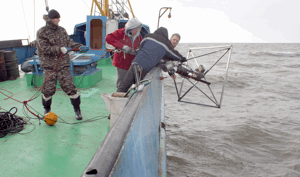
Scientists drop a tool in the ocean that allows them to record the sound of methane bubbling up from the seafloor. (Photo: Igor Semiletov, University of Alaska Fairbanks)
YOUNG: It’s Living on Earth, I’m Jeff Young. Recent discoveries on the floor of the Arctic Ocean have raised interest and concern about methane and its role in climate change. A study in the journal Science found permafrost under the East Siberian Arctic Shelf is not so permanent. Some of it is melting and as it does, it leaks methane into the atmosphere. Previous studies found a similar phenomenon in the waters off of Norway.
This raises a troubling scenario, because methane is a powerful greenhouse gas.
If warming waters melt enough of these frozen hydrates of methane, it could lead to a sort of feedback loop amplifying climate change. Dr. Matthew Reagan at the Lawrence Berkeley National Laboratory is working on models of these methane releases.
Welcome to the program.
REAGAN: Hello, Jeff.
YOUNG: So, why are we concerned about these releases of methane from the oceans?
REAGAN: Well, recently scientists have realized that vast quantity of methane that exists in the oceans and in the permafrost in various forms. And as the climate warms the oceans warm in concert and various processes may cause this methane to enter the ecosystem. First, in the oceans, and then possibly into the atmosphere.
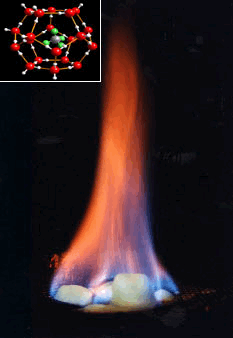
Frozen methane on fire. (Courtesy of the United States Geological Survey)
YOUNG: So this most recent study looked at the East Siberian Arctic Shelf, which I guess is fairly shallow water. But that’s not the only spot where scientists are finding this, right?
REAGAN: That’s correct. In fact, about a year and a half ago, an expedition in the Bering Sea Svalbard area found a series of methane plumes erupting from the shallow continental shelf west of the island of Spitsbergen. And what was interesting about these plumes was not only their existence and their size, but that we see plumes erupting out of the sea floor in some 390, 400 meters of water and reaching high up into the water column.
And in the case of the East Siberian Arctic Shelf we also see that the methane is passing through the water column and reaching the atmosphere. Previous studies thought that much of the methane would be oxidized in the oceans and release to the atmosphere would be minor. But now we’re seeing releases that are both large enough and shallow enough to let that methane get into the atmosphere.
YOUNG: Give me a sense of how much methane we’re potentially talking about?
REAGAN: Various numbers have been thrown out, but we estimate that the quantity of methane in gas hydrates exceeds, possibly by a factor of two, all of the carbon in developed and undeveloped fossil fuel reservoirs.
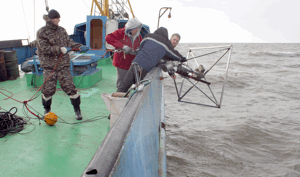
Scientists drop a tool in the ocean that allows them to record the sound of methane bubbling up from the seafloor. (Photo: Igor Semiletov, University of Alaska Fairbanks)
YOUNG: So, do we know that this is a new phenomenon, that it really is melting because the seas are getting warmer, or is this something that maybe has been going on for a long time and we just never noticed it?
REAGAN: You know, we don’t know. In the Bering Sea Svalbard area the region had experienced warming of the ocean in recent times that’s documented. However, these observations have only been made recently. So what we have to do is often supplement these observations with modeling to try to figure out whether these processes have the potential to cause methane release in this form, or if perhaps the methane is not tied to say, recent temperature change and is something that’s been chronic and been happening for awhile.
YOUNG: So tell me about methane as a greenhouse gas. How does it compare to carbon dioxide in its ability to trap heat?
REAGAN: Well, methane, depending on how you assess its impact can be 20 to 40 times as powerful a greenhouse gas as carbon dioxide. However, methane’s residence time in the environment is much less than that of carbon dioxide. Methane oxidizes to carbon dioxide on time scales of decades, while carbon dioxide can be with us for thousands of years.
YOUNG: So, methane: very powerful greenhouse gas, but it doesn’t stick around that long. So the trick then, I guess, is you have to figure out how much of what is getting to that atmosphere all at once.
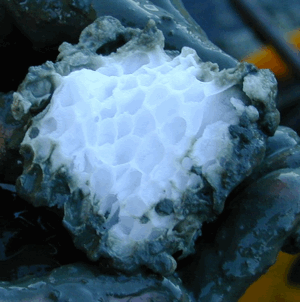
Methane “ice” pulled from a subduction zone off Oregon. (Photo: Wikimedia Commons)
REAGAN: Yes, both how much can be released to the atmosphere and more importantly, how quickly can it be released to the atmosphere? The key to understanding the effect of methane is knowing the rate of release into the environment. Also to know that rate of release we need to understand the fate of the methane as it’s released.
YOUNG: So if we do get a big burp of methane all at once that might be one of what we call a -- I guess a feedback loop, right?
REAGAN: That is what has been hypothesized and what scientists have been concerned about for many years. When you look at the sheer size of the methane reservoir there is a reason to be concerned. However, I don’t think we should be scared and I don’t think we should be sounding alarms just yet. What we need to do is do the work and study the situation. Scientists are just starting to quantify this.
The observations off of Spitsbergen, the recent discovery in the East Siberian Arctic Shelf, these are key because they are the first real evidence that this release may be happening now, and this is motivating scientists to study the problem even harder.
YOUNG: So if we’re just now starting to get a handle on the mechanism of this potential feedback loop that means that this sort of stuff has not yet been fed into climate modeling for what the impact of climate change might mean?
REAGAN: No, and in fact, our project here at Berkeley Lab in collaboration with Los Alamos and Lawrence Livermore Labs is to track methane from the sediments, from release from hydrates in the sediments up into the ocean water column, study how it affects of ocean chemistry, assess whether that methane can be released into the atmosphere, and if so, how much? This data will all going into climate models and tell us whether methane is truly a concern.
YOUNG: Dr. Matthew Reagan at Lawrence Berkeley National Laboratory. Thank you, sir.
REAGAN: Thank you very much.
Related links:
- For more about recent discoveries of methane releases, click here.
- Click here to learn more about methane and climate change.
- For more about Matthew Reagan’s work, click here.
- To learn more about methane releases on the West Spitsbergen continental margin, click here (subscription only).
Tree Planting for Carbon Raises Questions

Baby pine trees mark Uganda's first tree carbon project. (Photo: Beth Hoffman)
YOUNG: Thirteen years ago the negotiators of the Kyoto Climate Accord decided there should be some way for rich countries to pay for clean, low-carbon development in poor countries. The CDM or Clean Development Mechanism was born. It helps polluters in wealthy countries purchase things like clean furnaces in Vietnam and pollution control equipment in Brazil. The CDM also pays people in poor countries to plant and protect forests. Reporter Beth Hoffman visited the first place in Africa to qualify for tree money – southwestern Uganda – and found mixed results.
HOFFMAN: Alanzio Gakibayo’s black socks droop in his worn leather shoes, and his teeth are few and far between. Dressed up for a visitor, in a sweater vest and black slacks, he and his colleagues laugh at the idea that he, an old man, just recently planted trees.
[PEOPLE LAUGHING]
GAKIBAYO: I am 75 years of age. I planted them to get money.
HOFFMAN: But you won’t be able to cut them down?
GAKIBAYO: No, I won’t be able to [EVERYONE LAUGHS] because I am too old to do it. I am too old. I’m still hoping to get money from carbon.
HOFFMAN: Until now, these friends say, there was no reason for a 75-year-old man to a plant tree here. But now they will be paid just for planting trees and taking care of them.
GAKIBAYO: Even my children and even my grandchildren, will also get money. That is why I planted them.
HOFFMAN: Gakibayo is a member of the Rwoho Environmental Conservation and Protection Association – the first group in Africa to be promised money for storing carbon, in trees.
[BYESIGWA SPEAKING]
VOICEOVER: The Conservation and Protection Association really started around 2003.
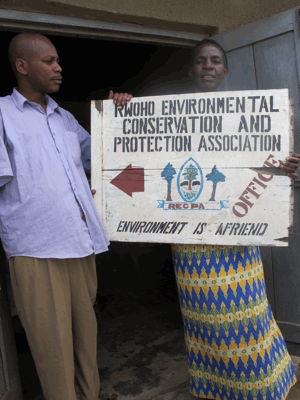
Villagers in Rwoho, Uganda formed their own environmental association after they'd been planting trees on their own, and officials took note. The officials wrote the villagers into their World Bank carbon project plans. (Photo: Beth Hoffman)
HOFFMAN: Jerome Byesigwa chairs the group and explains how it started. In 2003, he says, the weather in the area suddenly changed when the government cut down much of the nearby Central Forest Reserve for timber. The rains stopped, and banana groves and corn stalks died.
[BYESIGWA SPEAKING]
VOICEOVER: As soon as it had been harvested we realized there was a change in the weather. Just even ordinary people would tell you that the problems we were experiencing were because our forests there had been harvested.
HOFFMAN: So members of this community decided to plant trees on their own land.
[BYESIGWA SPEAKING]
VOICEOVER: The driving force was people wishing to manage their own environment.
HOFFMAN: Soon Uganda’s National Forestry Authority took notice.
[BYESIGWA SPEAKING]
VOICEOVER: They were seeing people planting and said – these people are interested. If we really give them some technical knowledge and some guidelines, maybe they could do better.
HOFFMAN: So forest officials decided to include the community in their plans to get international money for planting trees. With funding from the World Bank, they’re now planting 5,000 acres. Of this, they gave the community 150 acres to use, free, along with seedlings to plant.
[BYESIGWA SPEAKING]
VOICEOVER: We were given land to plant.

Baby pine trees mark Uganda's first tree carbon project. (Photo: Beth Hoffman)
HOFFMAN: The community is responsible for costly weeding, thinning and fire protection. And now they wait, not so patiently, for the carbon credit money to someday come rolling in.
[BYESIGWA SPEAKING]
VOICEOVER: To this end we had an accountant from the World Bank, and he promised “as soon as possible” money will begin flowing in.
[SOUNDS OF BOUNCY TRUCK SQUEAKS]
HOFFMAN: About a 20 minute drive from Rwoho on rutted, muddy roads brings you a small, crooked sign buried deep in weeds that says: RECPA Carbon Project Area, Funded by World Bank.
[SOUNDS OF TRUCK DOORS SLAMMING]
HOFFMAN: Beside it stand straight rows of young pine trees, like a Christmas tree farm. Below, in the low lands, is young eucalyptus, a tree native to Australia. Both trees require a lot of water. So much water in fact, that many eucalyptus were cut down in neighboring Kenya recently because of the drought.
[SOUNDS OF WALKING THROUGH FOREST]
HOFFMAN: But these trees were not selected for their environmental friendliness. They were chosen because they grow fast, and straight. They make good timber.
[KASIMBAZ SPEAKING]
VOICEOVER: This crop on the left was planted March and April 2006.
HOFFMAN: That’s Lemme Kasimbaz, a Ugandan forest supervisor. He refers to the trees as a crop.
[KASIMBAZ SPEAKING]
VOICEOVER: The rotation age here is 20 years. If you don’t harvest them, they can get spoiled.
HOFFMAN: It turns out this is a tree plantation. As long as the trees stand for 20 years before they're clear cut, the World Bank and United Nations allow the carbon they accumulate to be bought and sold by investors. World Bank officials would not speak on tape, but they explained that growing trees for timber will help improve degraded grasslands here. And people will also stop cutting down native trees elsewhere. At the Community Forestry Department at Makerere University, Mukadasi Buyinza says the project is short sighted.
BUYINZA: Finally, the forests will be harvested. And that carbon that has been stored will have to be released at one time. So clearly, it is a way we are postponing a problem.
HOFFMAN: In a village a few miles away, young Tiboruhame Johnson says he used to graze cows on government lands in these hills.
[JOHNSON SPEAKING RUNYANKOLE-RUKIGA]
VOICEOVER: Before we grazed on this land and grew crops, it was open and free for us to use. And we could make money.
HOFFMAN: But there’s no place to grow bananas and corn among the trees in the new project, because the pine and eucalyptus are closely spaced, to maximize carbon absorption. The lands are now off limits to the community.
[JOHNSON SPEAKING RUNYANKOLE-RUKIGA]
VOICEOVER: The carbon forest has changed our lives. Now we are forced to look for money elsewhere. We’ve even sold a lot of our cows and goats because there is nowhere to graze them. We’re not so happy about this forest project.
BUYINZA: That area. If you lock up such a big area in forestry that means you have deprived the community was using this area for arable farming, also for grazing. Therefore their food security is at stake and it is not secure.
HOFFMAN: While growing trees may be a step in the right direction, this first tree-carbon project in Africa appears to raise many questions. The neighboring community is deprived of cropland, which means less food. The tree species chosen require a lot of water in a region where rains are now unpredictable. And they'll be cut down and their carbon released in 20 years. But for now, back in Rwoho, Alanzio Gakibayo says the trees have made a positive difference.
GAKIBAYO: Now, I’m benefiting from the forest. I enjoy the rainfall that falls down. Formally, we did not get enough rainfall. But now we are getting it. We get plenty. So I am enjoying my planting of trees. I am enjoying it a lot.
HOFFMAN: For Living on Earth, I’m Beth Hoffman in Southwestern Uganda.
MUSIC: The Jazz Crusaders: “Tough Talk” from Lighthouse 68 (Pacific Jazz 1968/Reissue Blue Note Records 2004)
YOUNG: Coming up – nature writer Rick Bass and the “All-right” of spring. But first this note on Emerging Science from Emily Guerin.
Nuclear Shop of Horrors
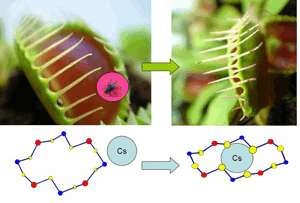
(Image: Mercouri Kanatzidis, Courtesy Argonne National Laboratory)
[SCIENCE NOTE THEME]
GUERIN: Scientists have long taken inspiration from nature when designing products. Cars are streamlined like fish for better aerodynamics; swimsuits are made of imitation sharkskin to move efficiently through water. The newest copycat looks to the Venus flytrap to clean up nuclear waste. Researchers at Northwestern University have designed a synthetic material that will snap up radioactive cesium ions from nuclear waste, leaving harmless ions behind. This is no easy task: safe ions in the waste, such as sodium, outnumber cesium by a ratio of almost one thousand to one.

(Image: Mercouri Kanatzidis, Courtesy Argonne National Labrotory)
Here’s where the Venus flytrap idea comes in. The carnivorous plants are very sensitive and only clam up if multiple hairs on their leaves are touched. This allows the flytrap to distinguish between living prey and inanimate objects, like falling raindrops or debris. The researchers came up with a material made with sulfur ions to mimic the plant’s behavior. When the sulfur and cesium ions meet, the material’s pores close around the cesium, trapping it inside like an insect within a Venus flytrap.
Only cesium triggers the reaction – the material ignores sodium the same way the flytrap ignores rain drops. Scientists say more research is needed. But maybe some day nuclear power plants will send their waste to the radioactive equivalent of a Little Shop of Horrors, complete with a cesium-devouring plant named Audrey. That’s this week’s Note on Emerging Science. I’m Emily Guerin.
Related link:
For more on nuclear waste-feeding plants, click here.
Spring's A Comin'
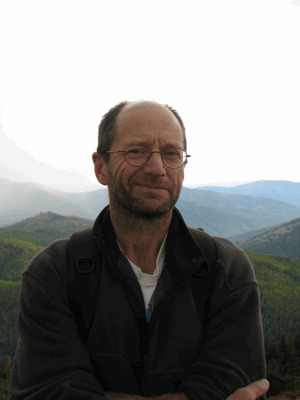
Rick Bass (Courtesy of Rick Bass)
BASS: The marsh is still a mottled slab of snow and ice, but with a few standing puddles of water.
YOUNG: In northern Montana, writer Rick Bass sees signs that spring is near.
BASS: The once opaque ice is thinning now to silver green hues of translucence.
The heavier, sturdier birds are returning first – the powerful ducks and geese, birds flying across the top of the forest each night, returning like rising water levels themselves, hurrying to fill the new spaces created by the snow’s departure.
The snow is not yet going away for good. But the struggle has begun in earnest – the land rush is on – and as the snow and ice begin to disappear, the ducks and geese are claiming the new water, pothole by pothole, wing-splash by wing-splash.
By mid-March, they are pouring in like bats. Their unseen wing-whistling is heard always at dusk, so that it seems to me as if with their enthusiastic return they are helping to nudge along the advancing equinox – the return of enough light, finally, to balance the dark.
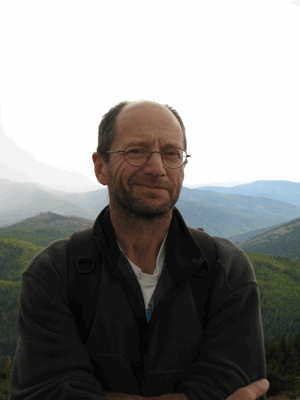
(Courtesy of Rick Bass)
It’s still cold and snowy, but somewhere – if not yet on the marsh – there’s one more new slot of open water, just ahead, just-opened; and they’re anxious, it seems, to be the first to reach it. Perhaps in their power and rush they are not just moving us toward the equinox, but are in fact attempting, with their momentum and desire, to speed it along. It’s easy to imagine that with their fast strong flights they are finally pulling back the covers off winter, finally revealing the bare, black earth of spring, and the coming meadows and marshes that will one day be as brilliantly green as the jeweled feathers on the heads of the mallard drakes that are now re-inhabiting them.
You can’t see any of this, at night, nor into the future. But it’s up there, and out there – close enough to hear, if not quite yet see. Whispered promises, now. Pulling my youngest daughter, Lowry, on her sled across the crust of vanishing marsh ice, skirting around the shallow puddles – each day seems to be the last day, then the last hour, I can do this. The trail, the wake, of our fractured ice glints and glitters like a path of diamonds. It seems to me that it is the thunderous, rasping noise of the steel runners themselves, the tympanic rumbling that will urge the spring along, as much as the whistle of duck wings at night. So much noise: as if these rasps and rumblings, and even her delighted laugh, are what will awaken the sleeping season.
YOUNG: Writer Rick Bass lives in the Yaak Valley near Troy, Montana. His novel, Nashville Chrome, will be published this fall.
Related link:
For more information on Rick Bass, click here
MUSIC: Les Mangelepa “Odesia” from GuItar Paradise Of East Africa (Earthworks 1990)
YOUNG: In just a minute, protecting our most important crop by saving seeds. The seed banker, just ahead on Living on Earth.
Seeds of Resistance

The main entrance to the Svalbard Global Seed Vault. (Photo: Wikimedia Commons)
YOUNG: It’s Living on Earth, I’m Jeff Young. Bread, pasta, pita, tortillas: wheat feeds the world – providing a quarter of humanity’s calories. Yet those who devote their careers to protecting this vital crop largely toil in obscurity. Biographer Susan Dworkin wants to change that. Her new book is “Viking in the Wheat Field: A Scientist’s Struggle to Preserve the World’s Harvest.” It focuses on one scientist’s work to save the diversity of wheat plants. And Ms. Dworkin begins her story with a current – and alarming – example of why we need that diversity. She tells us about a wheat pest first spotted in Uganda called Ug99.
DWORKIN: Ug99 is a variety of disease called stem rust. Which is the most pernicious and terrible disease of wheat. And since wheat gives us 25 percent of the world’s calories, any disease that is that dangerous to the wheat crop is something we must be very concerned about.
YOUNG: Where is this disease now?
DWORKIN: It’s a fungal disease, which is spread by spores and these spores blow on the wind. So there’s no way to control where the wind blows, and the wind blew the spores of Ug99 into Kenya, and then it blew the spores across the Red Sea into Yemen, and then it blew the spores north up the Arabian Peninsula into Iran where it has currently taken hold and where they’ve had terrible losses in the wheat crop because of this terrible disease. Now if it moves out of Iran and it moves into India and Pakistan, which gives us 20 percent of the world’s wheat, once it jumps the Himalayas it gets to China, the next stop is the Ukraine, Kansas, France, the world.
YOUNG: We’re talking about the staff of life, here –
DWORKIN: That’s right.
YOUNG: Wheat. You’d think I’d have heard of it. How is it we’ve not heard about this?
DWORKIN: Because there’s a terrible information gap in our country. The farmers have heard about it, the United States Department of Agriculture has heard about it, but the vast majority of Americans who just eat haven’t heard about Ug99. In fact, they haven’t heard about any major agricultural issue.
YOUNG: So what’s our defense, what do we do about a disease like this?

The main entrance to the Svalbard Global Seed Vault. (Photo: Wikimedia Commons)
DWORKIN: A number of scientists from 40 different countries get together and they have begun looking for traits that would impart resistance to the wheat and immunity. The way to do that is to look into this network of seed banks, which we have in this world for every crop from apples to flax – these are collections of traits and genes from different varieties of this crop. And when you need to find a new trait to breed into the old wheat to meet a new stress like Ug99 – you go into the gene banks and you look around for the right traits, and then you re-breed the crop. And the man who I wrote about in “The Viking in the Wheat Field” was the greatest gene banker that we’d had in the world, and his name was Bent Skovmand, and he was an expert.
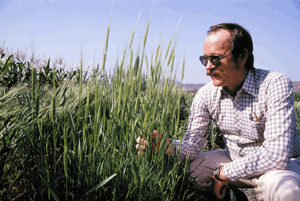
Bent Skovmand (Photo: Skovmand Collection)
YOUNG: What was it in his work that made him realize the importance of expanding and protecting these seed banks?
DWORKIN: He went to work for a man named Norman Borlag, who won the Nobel Prize for the Green Revolution, which distributed seed during the ‘60s to places where there was endemic famine. Skovmand was like all the disciples of Borlag primarily a hunger-fighter. These were people who really believed that endemic famine was not necessary in this world. That India, which had a famine that killed five million people every 15 years, that that didn’t have to happen. That if you could reorganize local agriculture, and provide the kinds of wheat that would resist bugs like Ug99, or drought, or frost that local agriculture could feed the people and prevent famine.
YOUNG: You recount a lot their work, and a lot of the wheat varieties that we take for granted came about through amazing happenstance.
DWORKIN: Right. I’ll tell you the story: there was a very great plant collector named Jack Harlan, who worked for the Department of Agriculture in the ‘40s and ‘50s. And he was out looking for wheat varieties in Turkey one day. And there was one plant that was the ugliest – he says, ugly, downtrodden, kind of smooshy plant that didn’t have any elegance to it, and he said – uch, I’m going to put it in the bag, too. Some years later, there as a terrible outbreak of rust in the Pacific Northwest – really decimated the wheat crop. And the plant that had the resistance to the new strain was this ugly, horrible plant that Harlan had put into his sack in Turkey.
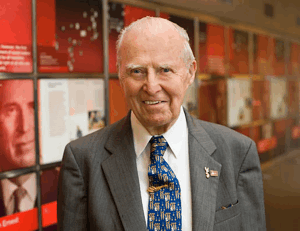
Norman Borlaug during his visit to the Nobel Peace Center on 1 September 2006. (Photo: Trond Isaksen, Copyright © Nobel Peace Center 2006)
YOUNG: It’s like the wheat version of the “Ugly Duckling” or something?
DWORKIN: Exactly, exactly.
YOUNG: So, the lesson here is save everything.
DWORKIN: Save everything. And that’s what Skovmand always said.
YOUNG: How are we doing, though, in terms of saving everything when there’s such drive for monoculture, to just grow one thing and plow everything with that one crop?
.gif)
Norman Borlaug (Photo:CIMMYT)
DWORKIN: The truth is that business loves monoculture, nature loves diversity. The reason we have monocultures of such enormous acreage in our country is because when a crop is profitable all farmers want to plant it, and the major corporations want to sell it. On the other hand, if you have fewer and fewer varieties, if you have a smaller and smaller genome with which to rebreed the crop when disaster strikes.
YOUNG: But what about as climate change begins to take effect. Is the variety that we have in a seed bank going to help us when the weather changes in our breadbasket?
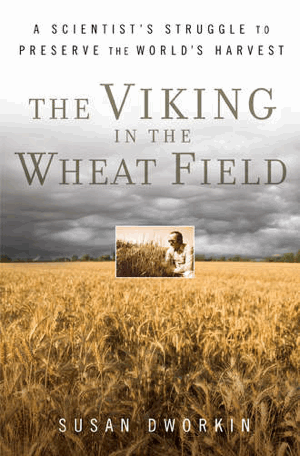
DWORKIN: Yes, it is. Global warming changes the environment in which the plant lives. So if you need to have wheat for example in Australia where there’s been terrible drought, you’re going to go look in a gene bank, you’re going to find a wheat that grew in Mexico in desert conditions, you’re going to take some genes from that variety, put it into the Australian wheat, and that’s how you will defend the Australia crop against global warming.
YOUNG: Mr. Skovmand was clearly visionary when it came to saving seeds. He also was one of the early people to see this tension that was arising between keeping this information public versus the desire by corporations to make it private.
DWORKIN: In 1980 the Supreme Court ruled that forms of life could be patented and held privately. That meant that the great corporations in the chemical business had a kind of leg up on the seed business because they could reinvent seeds with new qualities and new traits, based on what they knew of chemistry. Skovmand was very much against the patenting of life forms. He said, patenting a gene was like patenting every word in “Hamlet”; you’d have to pay Shakespeare every time you used a word in “Hamlet”. So, to, that’s a nickel; be, that’s another nickel; or, that’s another nickel, right? To him it was insane because it has narrowed agricultural research to those crops which bring a profit. So nobody’s doing research to increase the genetic wealth of sorghum or cassava, which are the staples of the developing world. Whereas corn and soybeans and cotton – those crops are very, very much worked on by the private sector.
YOUNG: So, what do you think is the takeaway lesson from learning about Mr. Skovmand’s life and work?
DWORKIN: The takeaway lesson for me, and I’m an urban woman, I am a New Yorker, was that we can no longer allow agriculture policy to be made essentially in secret by a few government officials and a few corporations; we have to understand what makes agriculture go, what makes food security possible. If we can do that we can join the civic conversation about what should be American policy regarding agriculture. And then we aren’t separate from the farmers; we’re in one country with the farmers, really. And I wrote this book because I wanted people to know about a great public servant and I wanted people to become engaged in the civic conversation that controls policy in this country.
YOUNG: The book is called “Viking in the Wheat Field”. Susan Dworkin, thanks very much.
DWORKIN: Thank you for having me. It's a pleasure to be here.
Related links:
- To learn more about Susan Dworkin and “The Viking in the Wheat Field,” click here
- **WEB EXTRA** Listen to an extended interview with Susan Dworkin.
Hollywood’s Unrequited Scientist

Before becoming an award-winning filmmaker, Frank Capra aspired to be a chemical engineer.
[MOVIE MUSIC]
YOUNG: Sure, you saw Al Gore’s “An Inconvenient Truth.” But did you know Hollywood was already warning us about climate change almost 50 years before that?
["THE UNCHAINED GODDESS" FILM CLIP: Due to our release from factories and automobiles every year of more than six billion tons of carbon dioxide, which helps air absorb heat from the sun, our atmosphere seems to be getting warmer. And this is bad? Well, it’s been calculated a few degrees rise in the earth’s temperature would melt the polar ice caps!
[DRAMATIC MUSIC]
YOUNG: That film “The Unchained Goddess” was released in 1958. And it was produced by a Hollywood legend – Frank Capra, the man who gave us “It’s a Wonderful Life”. A clip from Capra’s remarkable climate change film has been making the rounds on the Internet. We asked Capra biographer Joseph McBride how Capra got involved in climate science – and it’s an interesting story. Mr. McBride, welcome to Living on Earth.
MCBRIDE: Hi Jeff, thanks for having me.
YOUNG: Now, you wrote a book where you had extensive access to Frank Capra. What’s behind this – I’ve got to say eerily prescient film “The Unchained Goddess” about climate change.
A clip from Frank Capra’s “The Unchained Goddess”
MCBRIDE: Well, Capra was, he had a very good scientific training and wanted to be a chemical engineer originally, and went to what is now Cal Tech and was then called Throop Institute of Technology in Pasadena. But he ran into some academic problems and shifted his focus to motion picture. But he always had a fascination with science and kept up with the field, and told me late in life that he maybe wished he had stayed in that field.
YOUNG: So Frank Capra, Hollywood legend, was really a frustrated scientist?
MCBRIDE: Yeah, I think so. He was also kind of a frustrated educator. In the 1950s his career as a feature film director foundered partly due to the blacklist era – he was under suspicion because his films had been sort of liberal and had social criticism, so he retired to his ranch in Fallbrook, California as was lured back by AT&T to make science films for children, played first on television, then distributed to schools. And he had a lot of input from important scientists in these films. So they’re smart, and they hold up well scientifically.
YOUNG: Now, in "The Unchained Goddess," it’s remarkable that there’s this animation that shows south Florida underwater: little boats going in the water, and then the buildings under the water there.
[DRAMATIC MUSIC]
["THE UNCHAINED GODDESS" FILM CLIP: Tourists in glass-bottomed boats would be viewing the drowned towers of Miami through 150 feet of tropical water.]
YOUNG: It’s a lot of fun, and it just seems so far ahead of its time, it really kind of blows your mind when you think this was made in 1958.
MCBRIDE: Well, one of the ironies is that Capra was a Republican, and a lot people think, mistakenly, that he was a liberal because his films are somewhat liberal in their orientation to some extent. But he was a lifelong conservative and that doesn’t stop him from being a good scientist and believing in climate change. Today, I think there’s this dichotomy between – you know, if you’re conservative you’re supposed to be antithetical to understanding climate change, which doesn’t make any sense. So you could say, it’s strange bedfellows, Frank Capra and Al Gore, but they’re more alike than Capra would probably like to admit.
["THE UNCHAINED GODDESS" FILM CLIP: Extremely dangerous questions, even now, man may be unwittingly changing the world’s climate through the waste products of his civilization. Not only dealing with forces of a far greater variety than even the atomic physicist encounters, but with life itself.]
MCBRIDE: Since he knew science unlike most filmmakers he understood deeper truths and future concerns. As far back as 1938 in his Oscar-winning film “You Can’t Take It With You,” Jimmy Stewart talks about solar energy, which is kind of astounding when you see that in 1938. And so, “Our Mr. Sun” is an early film advocating solar energy in 1956.
["OUR MR. SUN" FILM CLIP: Link the solar battery up! The recipe for this solar wafer sounds just like a vacation, just sand and sunshine. Exposure the wafer to sunlight, presto! The motor starts running with the efficiency of an automobile and nothing is used up but the sunshine, which is free! Ain’t that something? Well I’ll be darned!]
[YOUNG AND MCBRIDE LAUGH]
MCBRIDE: So, it filled the hole of the fact that he was creatively frustrated in the ‘50s when he was sort of a self-exile from Hollywood. It was a pleasure to be away from political pressure of making films about important, big issues – these were not considered important, big issues of the time. Ironically, now they are.
YOUNG: So what do you think Frank Capra might do in terms of the current climate change debate if he were with us today?
MCBRIDE: Well, I’m afraid since I know his M.O. that he would probably try to disassociate himself from “The Unchained Goddess” because he’d be on the wrong side of political spectrum. I’m saying that because, for example, during the Vietnam War, Capra gave a talk at a college in which he sort of disowned “Mr. Smith Goes to Washington” because he was highly critical of the American political system, which I think is kind of sad that he would sort of run away from the implications of his own films. But he was very traumatized by first, the reaction against “Mr. Smith” from some right-wing pundits and politicians, and then, the post-war backlash against liberal filmmaking, or left-wing filmmaking. So I think he’d be uncomfortable about being considered a man crying out in the wilderness that climate change is a problem.
YOUNG: You know, you got a lot of time to talk with him and it sounds like pretty personal conversations. What did he tell you about his early desire to follow science?
MCBRIDE: Well, I had a lot of very revealing conversations with him and he was very interesting to talk to, and we had a very good discussion, which I used to end my book, “Frank Capra: The Catastrophe of Success,” because I think it was so revealing. If you want me to I could read that discussion?
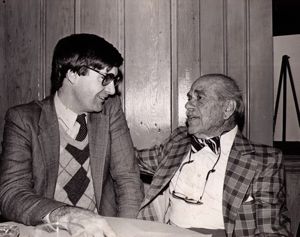
Joseph McBride and Frank Capra, 1985. (Photo by Columbia Pictures)
MCBRIDE: Well, I asked him if he thought he’d made the right choice to forsake his scientific ambitions for motion pictures, and he said, "not particularly." So, I said, "well, do you think you would have been happier in science?" He said, "yes." I said, "why?" He said, "I would have done more." I said, "where do you think you would have ended up?" He said, "with Dr. Hubble, Dr. Edwin Hubble as an astronomer – I could study the stars and the planets forever, I always wanted to know why, why!" "Then why didn’t you do it, what changed your mind?" "Pictures changed my mind, I was too far along in the movie business, but when I go to Cal Tech now and I hear things I’m not familiar with like black holes, damn, I get mad. How the hell I ever refused that, I don’t know. Whatever made me refuse it!"
So I think he believes scientists were doing more important things than motion picture directors.
YOUNG: You know, I want to go back to the 1938 film “You Can’t Take It With You.” And this moment where Jimmy Stewart’s character is talking about his enthusiasm for solar power – let’s hear just a bit of that:
["YOU CAN’T TAKE IT WITH YOU" FILM CLIP: I remember in college another guy and I had an idea – we wanted to find out what made the grass grow green because there’s a tiny little engine in the green of the grass and on the green of the trees that has the mysterious gift of being able to take energy from the rays of the sun and store it up. Well, we thought if we could find the secret of all those millions of little engines in this green stuff, we could make big ones, and then we could take all the power we could ever need right from the sun’s rays, you see?]
MCBRIDE: A fantastically well-acted scene. It goes on for actually four and a half minutes in one shot. So it’s very intimate and you get a real sense of the actors and – Capra and Robert Riskin, the screenwriter, had made a lot of changes in the play they had adapted there – “You Can’t Take It With You” – and they added that scene. And that was obviously very personal to Capra, Robert Riskin didn’t have a scientific background so I think we could safely ascribe that to Capra. And Jimmy Stewart is giving his talk about the potential of solar energy and then he expresses regret that he didn’t pursue it, so that definitely comes from Capra’s heart as well.
YOUNG: Joseph McBride is an associate professor of cinema at San Francisco State University and author of “Frank Capra: The Catastrophe of Success.” Thanks very much for talking to us.
MCBRIDE: Thanks for having me, it was fun.
The 1938 scene where Jimmy Stewart’s character talks about his passion for solar energy.
Related link:
For more on the book “Frank Capra: Catastrophe of Success,” click here.
ANNOUNCER: Funding for Living On Earth comes from the National Science Foundation supporting coverage of emerging science. And Stonyfield farm, organic yogurt and smoothies. Stonyfield pays its farmers not to use artificial growth hormones on their cows. Details at Stonyfield dot com. Support also comes from you, our listeners. The Ford Foundation, The Town Creek Foundation, The Oak Foundation—supporting coverage of climate change and marine issues. The Bill and Melinda Gates foundation, dedicated to the idea that all people deserve the chance at a healthy and productive life. Information at Gates foundation dot org. And Pax World Mutual Funds, integrating environmental, social, and governance factors into investment analysis and decision making. On the web at Pax world dot com. Pax World for tomorrow.
ANNOUNCER 2: PRI – Public Radio International
Living on Earth wants to hear from you!
Living on Earth
62 Calef Highway, Suite 212
Lee, NH 03861
Telephone: 617-287-4121
E-mail: comments@loe.org
Newsletter [Click here]
Donate to Living on Earth!
Living on Earth is an independent media program and relies entirely on contributions from listeners and institutions supporting public service. Please donate now to preserve an independent environmental voice.
NewsletterLiving on Earth offers a weekly delivery of the show's rundown to your mailbox. Sign up for our newsletter today!
 Sailors For The Sea: Be the change you want to sea.
Sailors For The Sea: Be the change you want to sea.
 The Grantham Foundation for the Protection of the Environment: Committed to protecting and improving the health of the global environment.
The Grantham Foundation for the Protection of the Environment: Committed to protecting and improving the health of the global environment.
 Contribute to Living on Earth and receive, as our gift to you, an archival print of one of Mark Seth Lender's extraordinary wildlife photographs. Follow the link to see Mark's current collection of photographs.
Contribute to Living on Earth and receive, as our gift to you, an archival print of one of Mark Seth Lender's extraordinary wildlife photographs. Follow the link to see Mark's current collection of photographs.
 Buy a signed copy of Mark Seth Lender's book Smeagull the Seagull & support Living on Earth
Buy a signed copy of Mark Seth Lender's book Smeagull the Seagull & support Living on Earth

